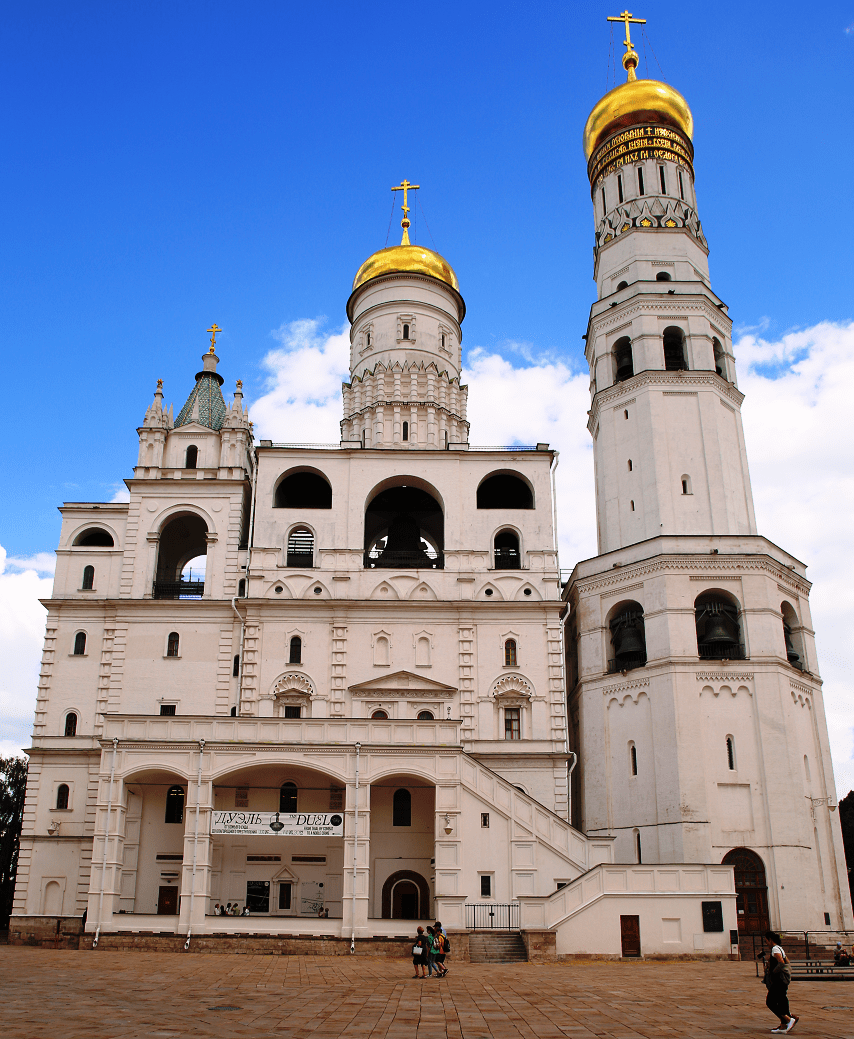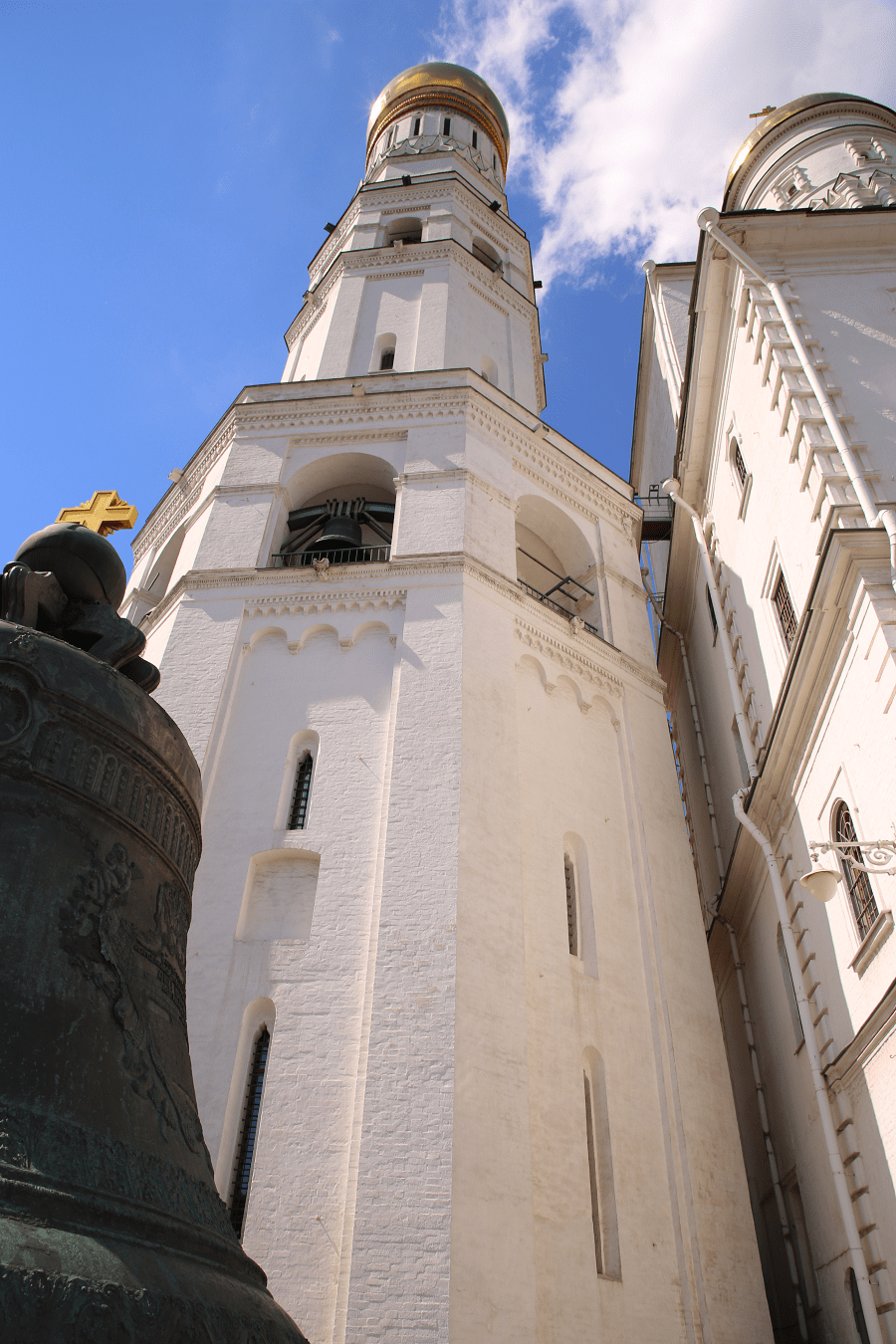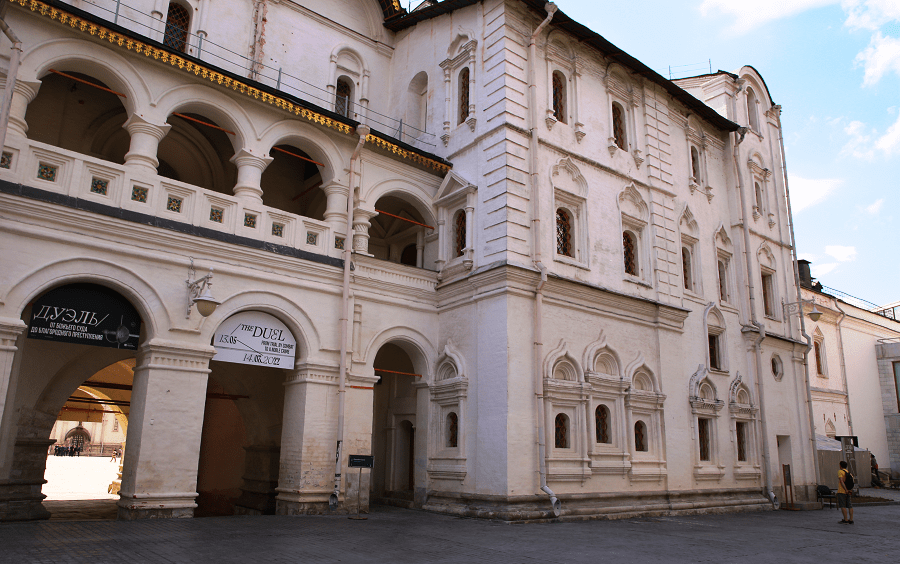The Ivan the Great Bell Tower (also sometimes referred to by the name of the main temple – the Church of Ivan of the Ladder) – is a church-bell tower as part of the architectural ensemble in Moscow on the Cathedral Square of the Moscow Kremlin. It was built between 1505 and 1509 according to the design of the Italian architect Marco Bon (or Bon Fryazin in Russian), and in the period up to 1815, it was repeatedly completed, expanded and rebuilt. The church of Ivan of the Ladder was laid at the foundation.
The architectural ensemble of the bell tower consists of three objects: the pillar of the Ivan the Great bell tower, the Assumption belfry and the Filaret extension. Includes a functioning Orthodox church, an exhibition hall of the Moscow Kremlin museums and a museum dedicated to the history of the architectural ensemble of the Moscow Kremlin.
In 1329, at the request of the Moscow prince Ivan Kalita, a church of the type “under the bells” was built on Borovitsky Hill. It received the name of the Byzantine theologian of the 6th-7th centuries, John of the Ladder, the eponymous holy prince. John Climacus, also known as John of the Ladder, John Scholasticus and John Sinaites, was a 6th–7th-century Christian monk at the monastery on Mount Sinai. The Latin Catholic, Eastern Orthodox and Eastern Catholic churches revere him as a saint.
It follows from the chronicles that the church was built in three months. This gave scientists reason to assume that the size of the temple was small.
The Church of Ivan of the Ladder is the first stone church with a bell known to researchers, the first pillar-shaped church-bell tower and the first church built between two cathedrals.
According to archaeological excavations by the historian Wolfgang Kavelmacher, the shape of the 14th-century temple resembled earlier Armenian temples “under the bells”. The building was octagonal on the outside and cruciform inside, with a semicircular apse in the eastern part of the cross and arches for bells in the second tier. Similar structures have been preserved in the churches of the Spaso-Kamenny and Trinity Boldin monasteries.
In 1505 the old church was demolished. To the east of it, the invited Italian architect Bon Fryazin built a new church. Construction was completed in 1508. The bell tower 60 meters high was crowned with a dome (another source says it was crowned with a brick tent).
The building created by Bon Fryazin turned out to be unique in its strength. For a long time, scientists believed that the foundation of Ivan the Great Bell Tower reached as deep as the level of the Moskva River. Upon closer examination, it turned out that the architect deepened the oak piles only to a depth of 4.3 meters, while they were placed one on top of the other and covered with white stone on top. Thanks to the conservation of groundwater, the piles are in the water and have been saved from decay. The foundation diameteris 25 meters. Above the foundation, there is a stepped white stone stylobate. The walls of the first tier are 5 meters thick.
In 1600, during the reign of Boris Godunov, the Russian architect Fyodor Kon built the third tier of the bell tower. The thickness of the walls of the built-on tier was only three bricks. The building reached a height of 81 meters and became the tallest in Moscow, which determined the name “Ivan the Great”. Upon completion of the construction, the head and the cross were brightly gilded, under which an inscription of gilded copper letters appeared.
In 1624, according to the project of the architect Bazhen Ogurtsov, the Filaret’s extension was created. It received a name in honor of Patriarch Filaret, the father of the first tsar of the Romanov family, Mikhail Fedorovich.
Finally, the architectural ensemble of Ivan the Great Bell Tower was formed by the end of the 17th century. By this time, it had become one of the main symbols of Moscow. The bell tower was used as the main watchtower of the Kremlin. It opened a view of the city and its surroundings, and the approach of enemy troops to the capital could be seen for 30 kilometers.
Attempts to erect buildings higher than Ivan the Great Bell Tower failed for a long time. In 1707, the Menshikov Tower, 84.3 meters high, was built. However, in 1723 lightning struck its spire, destroying the upper part of the building. Until the construction of the Cathedral of Christ the Savior in 1860, the bell tower continued to be the tallest building in Moscow.
After the Great Patriotic War, the church was converted into a museum. An exhibition hall of the Moscow Kremlin Museum was opened in the Assumption Belfry, where works of art from the Kremlin funds and other famous museums are shown.
Bell ringing in the tower resumed in Easter 1992. The bells were allowed to ring after scientists examined them. First, they were launched on the second, and then on the third tier of the bell tower. In 1993, for the first time since 1918, the largest of the bells, Uspensky, rang, but it is rarely used because the bell tongue weighs about 2 tons and needs to be adjusted to reduce the number of ringers. Currently, the bells are made during all divine services in the cathedrals of the Moscow Kremlin and during the divorce of the Kremlin guards.
In 2005-2007, the bell tower was restored. In 2008, work began on the museumification of its interiors in the bell tower. On May 18, 2009, the Museum of the History of the Moscow Kremlin and an observation deck was opened in the bell tower, which was timed to coincide with the celebration of International Museum Day. The second highest belfry in Moscow is in Novospassky Monastery, which opened after restoration in September 2017 (its height is 80 meters).
Bells
In total, there are 34 bells on Ivan the Great Bell Tower.
The main bells from the first tier:
Uspensky (weight – 65 tons 320 kg) – the second largest after the Tsar Bell of the Trinity Lavra. It is considered the best in tone and sound. Casters Yakov Zavyalov and Rusinov (the name of the master has not been preserved) recreated it. The bell is decorated with six high-relief portraits of members of the imperial family and relief icons above them. The name of the sculptor remains unknown.
Reut or Howler; weight – 32 tons 760 kg – Tsar Mikhail Fedorovich issued a decree in 1622 to make it and master Andrei Chokhov, known as the author of Tsar Cannon, built it. In 1855, during the solemn ringing on the ascension to the throne of Alexander II, the bell fell off, broke through five floors and killed several people.
Lenten or Seven Hundred (weight – 13 tons 71 kg) – located on the Filaret extension. Made in the 18th century by master Ivan Motorin, decorated with baroque ornaments and sculpted faces of angels.
Bear (weight – 7 tons 223 kg) – the oldest of the bells that have survived to this day. It got its name for its powerful voice and low sound. Ivan Alekseev cast it in 1501 and recast it in 1775 by Semyon Mozhzhukhin.
Swan (weight – 7 tons 371 kg) – got its name for the ringing, reminiscent of a swan cry. It was cast in the 16th century, during the reign of Vasily III. Semyon Mozhzhukhin cast it from an old bell in 1775 with the preservation of the former form and inscription.
Working days
The exposition in the bell tower “Ivan the Great” is open to the public every day, except Thursday, on sessions: 10:15, 11:15, 13:00, 14:00, 15:00, 16:00, 17:00 from July 31 to 30 September. In autumn and spring, the possibility of visiting the bell tower depends on weather conditions. In winter, the bell tower is closed to the public.
Tickets can be purchased:
45 minutes before the start of the session at the box office in the Alexander Garden from July 31 to September 30 from 9:00 to 16:30.
Day off is Thursday.
The ticket price for all categories of citizens is 350 rubles.
Entrance is strictly at the time indicated on the tickets.
The duration of the guided tour is 45 minutes.
You will hear a story about the history and architecture of the bell tower and the Kremlin, see authentic fragments of the white stone decor of the ancient Kremlin buildings, and from the open gallery you will admire beautiful views of the Kremlin and its surroundings.
Important:
the height of the rise is 25 meters, the number of steps is 137. A visit to the bell tower is possible from the age of 14.
Other places to visit inside the Kremlin ensemble
See also architecture of Moscow, churches and cathedrals of Moscow

















